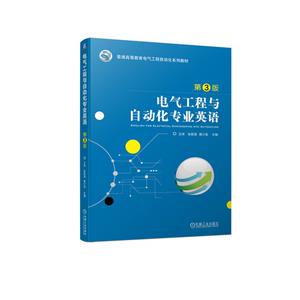-
>
中医基础理论
-
>
高校军事课教程
-
>
思想道德与法治(2021年版)
-
>
毛泽东思想和中国特色社会主义理论体系概论(2021年版)
-
>
中医内科学·全国中医药行业高等教育“十四五”规划教材
-
>
中医诊断学--新世纪第五版
-
>
中药学·全国中医药行业高等教育“十四五”规划教材
∈电气工程与自动化专业英语第3版 版权信息
- ISBN:9787111743446
- 条形码:9787111743446 ; 978-7-111-74344-6
- 装帧:平装-胶订
- 册数:暂无
- 重量:暂无
- 所属分类:>>
∈电气工程与自动化专业英语第3版 本书特色
本书遵循教指委相关指导文件和高等院校学生学习规律编写而成。践行四新理念,融入思政元素,注重理论与实践相结合。
∈电气工程与自动化专业英语第3版 内容简介
本书分为电气工程基础、控制理论与技术、电机与电器、电力系统4大部分,共20章,涵盖了电气工程及其自动化、自动化专业的主要专业基础理论内容,其中包括目前电气工程领域研究的热点内容。本书专业性和实用性强,注重从实际应用出发培养学生的专业英语阅读、表述和写作能力。书中所涉及的新能源技术、特种电机及微电网技术等内容可以作为思政元素,引导学生牢固树立低碳、节能、环保的意识及社会责任感。本书每章后均补充了必要的专业英语词汇及句子注释,并以二维码形式给出了各章词汇的音频,便于读者对各章知识点的正确理解和自学。
本书既可作为高等院校电气工程及其自动化、自动化及相关专业学生的专业英语教材,也可作为工程技术人员的自学参考用书。
∈电气工程与自动化专业英语第3版 目录
Chapter 1Circuit Fundamentals
1.1Electrostatic Charges
1.2Conductors, Insulators and Semiconductors
1.3Current, Voltage and Resistance
1.4Measuring Resistance, Voltage and Current
1.5DC Series Electrical Circuit
1.6Alternating Current Voltage
Chapter 2Analog Electronics
2.1Introduction
2.2Operational Amplifiers
2.3Differential Amplifiers
2.4Integrator and Differentiator
2.5Active Filters
Chapter 3Digital Electronics
3.1Introduction
3.2Digital Number Systems
3.3Binary Logic Circuits
3.4Combination Logic Gates
3.5Timing and Storage Elements
Chapter 4Power Electronics Technology
4.1Introduction
4.2Applications and the Roles of Power Electronics
4.3Structure of Power Electronics Interface
4.4Voltage-Link Structure Applications
4.5Recent and Potential Advancements
Chapter 5Magnetism and Electromagnetism
5.1Introduction
5.2Permanent Magnets
5.3Magnetic Field around Conductors and a Coil
5.4Ohms Law for Magnetic Circuits
5.5Domain Theory of Magnetism
5.6Electricity Produced by Magnetism
PART 2CONTROL THEORY AND TECHNOLOGY
Chapter 6Knowledge of Control Theory
6.1What Is Control
6.2Feedback
6.3PID Control
6.4Adaptive Control
Ⅵ电气工程与自动化专业英语目录ⅤChapter 7Motor Drives and Controls
7.1DC Motor Drives
7.2Inverter-Fed Induction Motor Drives
Chapter 8Programmable Logic Controller Technology
8.1Introduction
8.2PLC Operation Process
8.3PLC Maintenance Management
8.4The Application Future of PLC
Chapter 9Single Chip Microcomputer Control Technology
9.1Foundation
9.2A Single-Chip Microcomputer Integrated Circuit
9.3Digital Signal Processors
Chapter 10Computer Networking Basics
10.1Foundation
10.2Applications
10.3Requirements
10.4Links, Nodes and Clouds
10.5Network Architecture
10.6Network Security
PART 3ELECRICAL MACHINES AND DEVICES
Chapter 11Direct-Current Machines
11.1Introduction
11.2Basic Structural Feature
11.3Effect of Armature MMF
Chapter 12Three-Phase Induction Motors
12.1Introduction
12.2Construction of Three-Phase Induction Motors
12.3Principle of Operation
12.4Equivalent Circuit
Chapter 13Synchronous Machines
13.1Introduction
13.2Principle of Operation
Chapter 14Transformers
14.1Introduction
14.2Transformer Construction
14.3Ideal Transformers
Chapter 15Permanent Magnet Machines
15.1Introduction
15.2Introduction of PM Materials
15.3Classification of PM Motors
15.4Operational Principle of PM Motors
PART 4POWER SYSTEMS
Chapter 16Operating Characteristics of Modern Power Systems
16.1Transmission and Distribution Systems
16.2Power System Controls
16.3Generator-Voltage Control
16.4Turbine-Governor Control
16.5Load-Frequency Control
16.6Optimal Power Flow
16.7Power System Stability
Chapter 17Generating Plants
17.1Electric Energy
17.2Fossil-Fuel Plants
17.3Nuclear Power Plants
17.4Hydroelectric Power Plants
17.5Wind Power Systems
17.6Photovoltaic Systems
Chapter 18Concepts and Models for Microgeneration and Microgrids
18.1Introduction
18.2The Foundation of Microgrid Concept
18.3The Microgrid Operational and Control Architecture
Chapter 19High Voltage Insulation
19.1Introduction
19.2Lightning
19.3Switching Surges
19.4Insulation Coordination
Chapter 20System Protection
20.1Introduction
20.2Protection of Radial Systems
20.3System with Two Sources
20.4Impedance (Distance) Relays
20.5Differential Protection of Generators
20.6Differential Protection of Transformers
20.7Computer Relaying
- >
罗庸西南联大授课录
罗庸西南联大授课录
¥13.8¥32.0 - >
月亮与六便士
月亮与六便士
¥15.1¥42.0 - >
姑妈的宝刀
姑妈的宝刀
¥9.0¥30.0 - >
新文学天穹两巨星--鲁迅与胡适/红烛学术丛书(红烛学术丛书)
新文学天穹两巨星--鲁迅与胡适/红烛学术丛书(红烛学术丛书)
¥9.9¥23.0 - >
月亮虎
月亮虎
¥14.4¥48.0 - >
小考拉的故事-套装共3册
小考拉的故事-套装共3册
¥36.7¥68.0 - >
伯纳黛特,你要去哪(2021新版)
伯纳黛特,你要去哪(2021新版)
¥15.9¥49.8 - >
巴金-再思录
巴金-再思录
¥14.7¥46.0
-
食品添加剂
¥33.5¥45 -
VB语言程序设计
¥29.9¥39.8 -
C语言程序设计习题与实验指导
¥9.1¥18 -
地下建筑结构-(第三版)-(赠课件)
¥49.4¥55 -
模具制图
¥37.8¥49 -
工程机械结构认知
¥10.5¥22





















